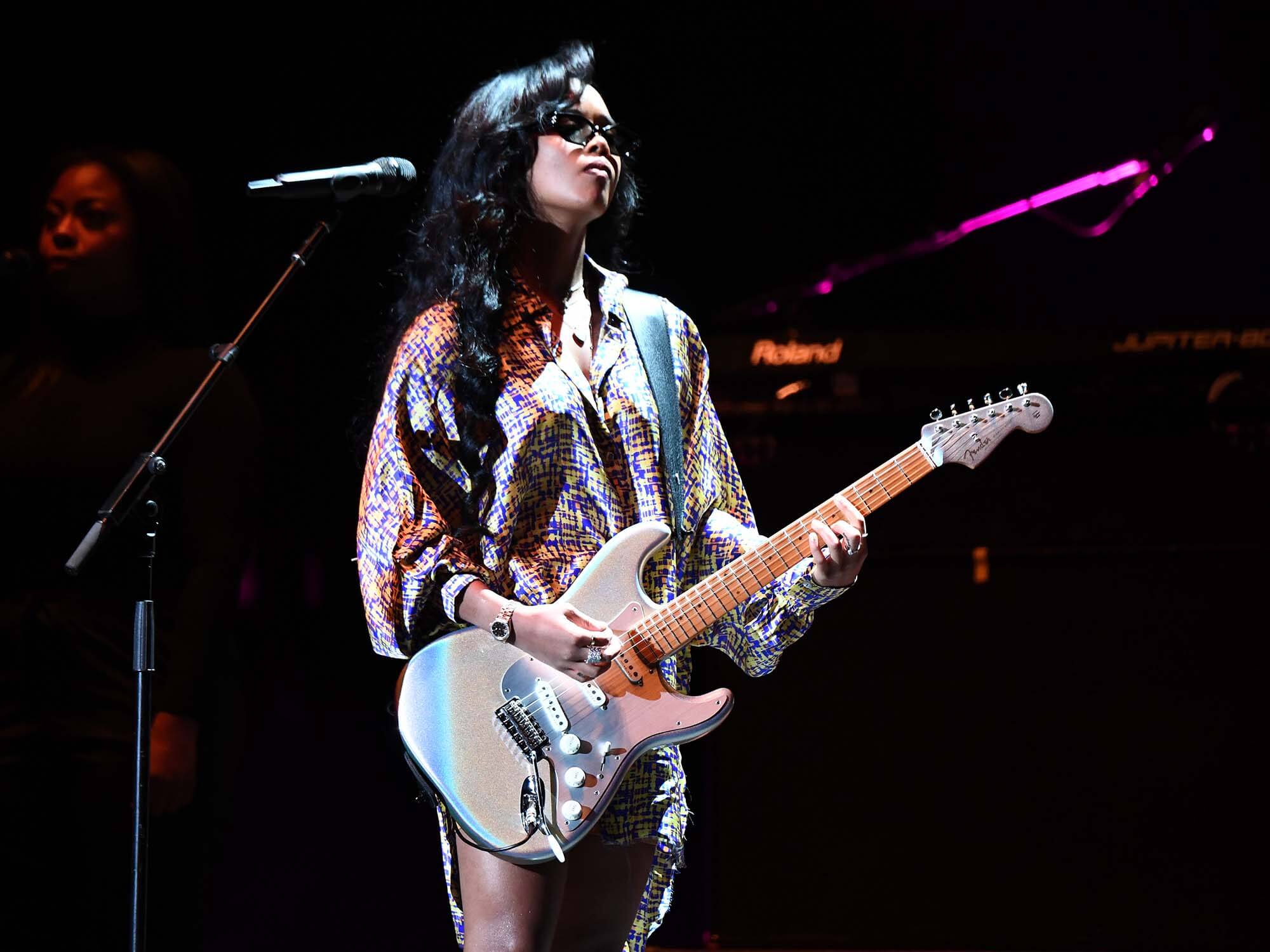The future is female: How the industry is changing to support a new age of women guitarists
With modern guitar culture increasingly being driven by the talent and creativity of female-identifying musicians, we examine how the guitar industry is looking to support and empower them.

H.E.R. (Kevin Mazur/Getty Images)
International Women’s Day is a time to celebrate impactful women in all industries, and guitar culture is no different – and we’re fortunate enough that the zeitgeist of modern guitar is increasingly being driven by female and female-identifying musicians. But as with any other industry, there is a huge amount of work to do and history to undo before women truly feel equal in the guitar world.
In recent years, many female guitarists, such as Alanis Morrisette, Lzzy Hale and Nita Strauss, have shared their distain at the guitar industry’s reaction towards non-male guitarists. Morrisette even declared in 2022 that “there is no need for me to spend time in an environment that reduced women”, and Hale stated that “[metal] has nothing to do with what’s between anybody’s legs.
The way that they are describing their place in the guitar world makes it seem in certain environments female guitarists are still treated as a rarity and are inferior to male guitarists, identical to how Mavis Bayton described the state of the guitar world back in 1998 in her ground-breaking book Frock Rock.
But we know that that isn’t true anymore, and that demographics are changing dramatically. Fender even published a report back in 2018 stating that half of all new guitar players were female, which according to CEO Andy Mooney was a “phenomenon”. So, why is the guitar market not adjusting to this drastic change to their consumer base?
It is clear that the guitar market has certainly changed in the past decade. Back in August, retailer Reverb and a study conducted by Find My Guitar showed this change in the consumer base, publishing statistics that show that demand for signature guitars created by female and non-binary is higher than demand despite only making up 6% of the market.
“Reverb found that similar to Find My Guitar’s research, signature models of female and non-binary guitarists account for 5.5 per cent of searches in the signature model electric guitar market,” the third-party retailer explained in a statement.
“Despite this, the listings for signature models of female and non-binary guitarists have a 14 per cent higher 30 day sell-through rate compared to other signature listings,” Reverb continued. “This means that the demand for signature models of female and non-binary guitarists like H.E.R.’s Signature Stratocaster or St Vincent’s Ernie Ball Music Man outpaces the inventory available for them.”
It’s clear then, that changes are needed to fulfil the changing consumer base, as more women and non-binary people than ever pick up the guitar. But how are the big names in the guitar industry responding to this change, and what more can be done to ensure that guitar is an inclusive environment for all?

Women lay the foundations
“Martin Guitar wouldn’t be the company it is today without female guitarists,” says Jason Ahner, Archives & Museum Management Manager at Martin. “From the very beginning, some of Martin’s most important and loyal customers were women. Early Martin guitars were relatively small compared to most of the models we build now, and you hear the term ‘Parlor Guitar’ used to describe these smaller guitars. The reason for this is that early on the guitar was an instrument that was mostly played by women, and they would entertain guests with their guitars in the parlours of their homes.”
It’s a lovely sentiment, but the role of women as trailblazers of guitar is not one that we see championed too often by the wider industry. Many of the greatest guitar players were and still are women, and it’s increasingly important for all of us that the big brands in our industry begin to celebrate these pioneering women, so we all get a better sense of the true history of the instrument.
And there’s been some progress in that regard in recent years. Gibson created a merchandise line and put on a tribute concert dedicated to the trailblazing SG-toting guitar icon Sister Rosetta Tharpe. Martin, meanwhile, has celebrated the hugely influential work of Elizabeth Cotten with a signature model based on her Martin guitar, and similarly honoured Joan Baez with a modern version of her trusty 1929 0-45.
Other manufacturers have taken different approaches to championing women guitarists, with Fender being a notable example of a company that is trying to celebrate the modern female guitar icons, while also doing its part to improve access to instruments and education through the Fender Play Foundation. Intiiatives like this are playing their part in helping to remove socio-economic barriers to young people learning to play guitar –especially girls and young POC.
The effort has so far provided 7,000 students in Los Angeles with access to equipment, and further supported California’s Proposition 28, Art and Music K-12 Education Funding Initiative, which according to Helena Ngo, director of artist marketing at Fender “is expected to result in over $900M of funding to schools across the state that lack music and arts resources”.
It’s admirable to see guitar manufacturers do more than simply produce guitars, and to not only tell stories from female legends of the past, but also help young female musicians of the future.

Social media is the key
“As a leader in the guitar space, we at Fender feel a responsibility to expand the guitar community for the long term, and help make guitar as accessible as possible to those seeking to play — no matter their gender, background, or musical style,” says Fender’s Ngo.
“One important aspect we are firmly committed to is the diverse representation in our content,” she continues. “In 2022, the majority of artists featured on Fender channels were women, non-binary, and/or people of colour. When young players see themselves in our content, it inspires them and opens up a world of possibility for their future in music. Content featuring artists of colour and women have been our biggest growth drivers on social media. In addition, we are seeing the community on our social channels skew younger, with more diverse followers on Instagram and TikTok specifically.”
TikTok and social media has already been seen as a driving force for many young girls to pick up the guitar. Fender held a panel in the summer of 2022 on this phenomenon, known as The #GuitarTok Effect.
“From what I understand there are 10 male bass players to every one female bass player,” shared bassist April Kae who was one of the panel guests. “By Fender creating a new version – or an expanded version – of what a bass player looks like through #GuitarTok, I have been able to find bass players that have backgrounds like mine, look like me and are from similar communities.”
Fender is not the only guitar manufacturer focused on social media and online initiatives to help draw in a new audience. Taylor Guitars’ Lindsay Love-Bivens – who’s main role at the manufacturer is to “strengthen women and POC representation” – regularly appears in the Taylor PrimeTime TV Show, in a bid to increase representation. Additionally, the brand also can point to a large variety of female-fronted artist/educational content on social media, which is a positive thing to see, while the gender ratio of players featured on their Instagram grid is impressively balanced.
Gibson too is trying to utilise social media to bring in a new audience, such as Instagram, where the brand posts content featuring a variety of musicians, like Wynona Judd and their first ever female guitar ambassador Lzzy Hale. However, in comparison to their competitors, they appear to be lagging behind in efforts to promote female guitarists in the same stead as their male counterparts. For example, Gibson’s Tik Tok includes over 20 videos, but not one of them features a woman. While the brand has increased the number of female signature artists and endorsees in recent years, it’s clear Gibson still has some work to do in promoting these artists to their audience in a more equal way.

The future is female
Despite the good work that has been done by these giants of the guitar world in recent years, the focus now is quite rightly on how the likes of Fender, Gibson, Martin and Taylor will continue to support female guitarists going forward.
“At Martin we greatly value female players and are always looking to work with exciting new female artists and influencers,” explains Mike Nelson, VP of Marketing at Martin. “Women are a fast-growing demographic of guitar players, so it is important for us to develop instruments and create marketing content that is inviting and inclusive. We believe there is an artist in all of us and we are dedicated to helping unleash that artist regardless of your gender.”
This sentiment has been emphasised by Fender’s Ngo, who states that “double standards are also a pain point for so many women, who have to deal with constant doubt from others about their playing ability, or from those who are asked what it’s like to be a ‘woman in music’ and to always have to be labelled as such when men are not.
“I believe we’ll see significant change as more women and people of colour are breaking through ceilings and growing their presence at the executive level across the music industry, on stages, and in the studio,” she continues. “At that point, we’ll see power dynamics shift to be more equitable and more safe spaces for talent in these communities to blossom. It’ll be an even playing field where anyone can have a great idea, get credit for it, and inspire others in their creativity.”
The efforts made by these manufacturers should not be understated, as they have all made strides to promote inclusivity within the guitar world, but there is still a lot more work to be done. It is hoped that with these continuing efforts by the biggest names in the guitar industry, not only will other manufacturers who don’t put the light on effort follow suit, but female and non-binary guitarists will feel more represented and valued as musicians.




